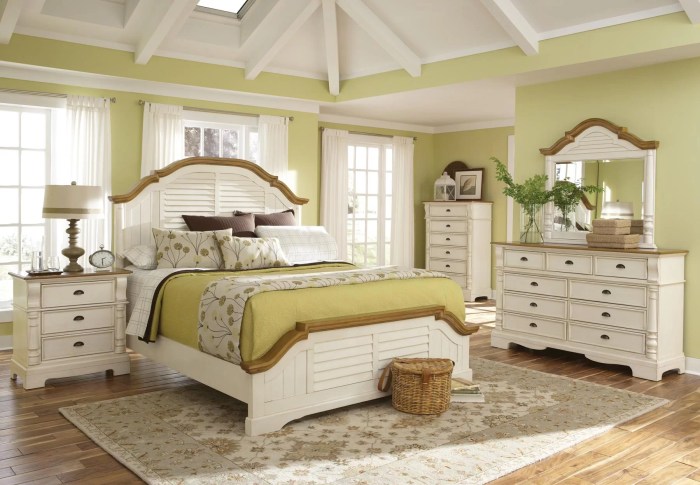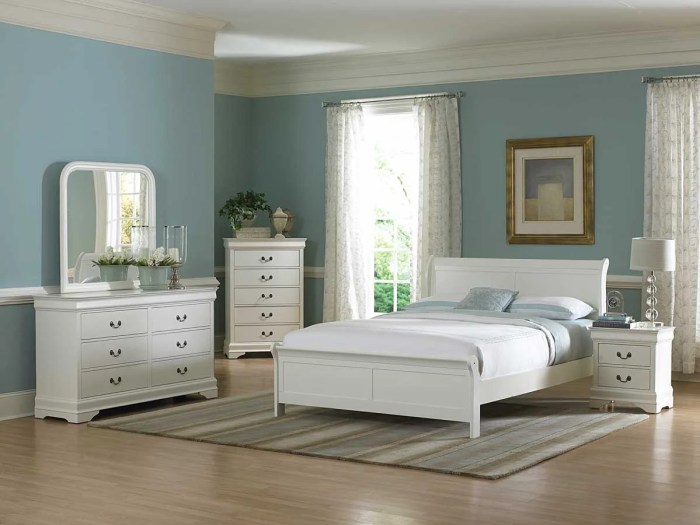The Impact of White on Bedroom Ambiance: White Furniture Bedroom Design

White furniture bedroom design – White, in its myriad shades, is a powerful tool in bedroom design, capable of dramatically altering the mood and perceived size of the space. Its impact extends beyond mere aesthetics, influencing our psychological well-being and interaction with the room’s lighting. Understanding these nuances is crucial for creating a restful and inviting sleep sanctuary.
Shades of White and Their Effects
Different shades of white evoke distinct feelings. Bright white, with its high reflectivity, creates a feeling of spaciousness and cleanliness, ideal for smaller bedrooms or those lacking natural light. However, its starkness can sometimes feel cold or sterile. Off-white, with its subtle undertones of cream, beige, or gray, offers a warmer, more inviting atmosphere, softening the intensity of pure white while maintaining a sense of airiness.
White furniture in a bedroom creates a serene, airy feel, perfect for a restful space. To achieve a truly sophisticated look, consider incorporating elements of a modern master bedroom design , which often complements the clean lines of white furniture beautifully. Ultimately, the calming effect of white furniture remains central to a successful bedroom design, no matter the overall style.
Cream, on the other hand, provides a cozy and comforting ambiance, particularly suited to larger bedrooms or those with ample natural light. The choice depends heavily on personal preference and the overall design aesthetic.
Psychological Impact of White in Bedrooms
White’s psychological impact is multifaceted. Its association with cleanliness and purity can promote feelings of calm and tranquility, contributing to a more restful sleep environment. The high reflectivity of white maximizes natural light, creating a brighter and more spacious feeling, even in smaller rooms. This increased brightness can elevate mood and energy levels during the day, while the calm associated with white promotes relaxation at night.
However, an overabundance of stark white can sometimes feel impersonal or even clinical, highlighting the importance of balancing it with textures and warmer tones.
White Furniture and Lighting Interactions
White furniture interacts uniquely with both natural and artificial lighting. In rooms with abundant natural light, white furniture reflects the light, enhancing the brightness and creating a sense of openness. This effect is particularly noticeable in rooms with large windows or skylights. With artificial lighting, the interaction depends on the bulb’s color temperature. Cool-toned LED lights can enhance the crispness of white furniture, while warmer-toned bulbs can soften its appearance, creating a more inviting atmosphere.
Careful consideration of both furniture placement and lighting choices is essential for maximizing the positive effects of white.
Comparison of White Shade Impacts
The following table compares the impact of different white shades on bedrooms of varying sizes and lighting conditions:
| White Shade | Small Bedroom (Low Light) | Medium Bedroom (Moderate Light) | Large Bedroom (High Light) |
|---|---|---|---|
| Bright White | Can feel stark but maximizes available light | Creates a bright and airy feel | May feel too intense, requires balancing with other colors |
| Off-White | Offers a warmer, more inviting atmosphere than bright white | Creates a balanced and comfortable space | Provides a subtle elegance and sophistication |
| Cream | Can feel slightly dark, needs brighter accents | Provides a warm and cozy ambiance | Creates a luxurious and relaxing atmosphere |
Incorporating White Furniture with Other Colors

White furniture offers unparalleled versatility in bedroom design, acting as a blank canvas for a spectrum of accent colors. The strategic use of color palettes alongside white furniture can dramatically alter the mood and visual appeal of the space, transforming it from minimalist haven to vibrant retreat. Choosing the right color pairings is key to achieving the desired atmosphere.Pairing white furniture with accent colors is a simple yet effective way to create a visually stunning and personalized bedroom.
The inherent neutrality of white allows for bolder color choices without overwhelming the space. This adaptability makes it an ideal foundation for a variety of design styles, from classic to contemporary.
Color Palette Combinations for White Furniture
The success of a white furniture bedroom hinges on thoughtful color selection. Certain palettes create a sense of calm and serenity, while others inject energy and excitement. Consider the desired mood when choosing your accent colors. A calming bedroom might benefit from cool tones, while a more energetic space could incorporate warmer hues. Careful consideration of these factors ensures a cohesive and aesthetically pleasing design.
Examples of Color Schemes and Their Effects
- Navy and White: This classic combination creates a sophisticated and nautical feel. Imagine crisp white bedding on a bed with a white frame, accented by navy blue throw pillows and a navy blue accent wall. The navy provides a grounding contrast to the bright white, creating a sense of calm and stability. This scheme works particularly well in larger bedrooms where the navy won’t feel overpowering.
- Grey and White: A versatile pairing that works across various design styles. Light grey walls paired with white furniture and grey accents like a rug or curtains creates a clean, modern look. Darker greys can add drama and sophistication, while lighter greys offer a more airy and spacious feel. This palette is adaptable to both minimalist and transitional styles.
- Pastel Shades and White: Pastel shades like blush pink, lavender, or mint green paired with white furniture create a soft, romantic atmosphere. Imagine a white dresser and nightstands against a pale lavender wall, accented with blush pink bedding and throw pillows. This palette is ideal for creating a tranquil and feminine space.
Color Scheme List with Examples
Below is a list outlining several color schemes suitable for bedrooms featuring white furniture. These pairings illustrate how different colors can influence the overall ambiance.
- Scheme 1: White furniture, Teal accent wall, Gold accents. This creates a luxurious and vibrant space.
- Scheme 2: White furniture, Muted Green accent wall, Natural wood accents. This provides a calming and earthy feel.
- Scheme 3: White furniture, Soft Pink accent wall, Rose gold accents. This produces a romantic and feminine ambiance.
- Scheme 4: White furniture, Charcoal Grey accent wall, Silver accents. This results in a sophisticated and modern atmosphere.
Choosing White Furniture Materials

Selecting the right materials for your white bedroom furniture is crucial for achieving both the desired aesthetic and long-term durability. The choice will significantly impact the overall look, feel, and longevity of your space. Different materials offer unique advantages and disadvantages, requiring careful consideration based on individual needs and preferences.
White Wood Furniture
Solid wood, such as oak, maple, or pine, offers a classic and timeless appeal. White-painted wood furniture exudes a sense of sophistication and can complement various design styles. However, solid wood is typically more expensive than other materials and requires more maintenance to prevent scratches and water damage. Regular dusting and occasional polishing with a suitable wood cleaner are essential.
Minor scratches can often be repaired with touch-up paint. While durable, exposure to direct sunlight can cause fading over time.
White Metal Furniture
Metal, often steel or iron, provides a sleek and modern look. White-painted metal furniture offers a clean, minimalist aesthetic. It’s generally more durable and resistant to scratches and stains compared to wood. However, metal can be susceptible to rust if not properly treated, particularly in humid environments. Regular cleaning with a damp cloth is usually sufficient.
Protecting it from moisture is key to its longevity. The potential for cold surfaces in colder climates should also be considered.
White Plastic Furniture, White furniture bedroom design
Plastic furniture offers a budget-friendly option and is readily available in various styles. White plastic furniture is easy to clean and maintain, making it ideal for families with children. However, plastic can be less durable than wood or metal, and it may not have the same aesthetic appeal. Scratches and chips are more visible on plastic, and prolonged exposure to sunlight can lead to discoloration.
Regular cleaning with mild soap and water is sufficient.
Comparison of White Furniture Materials
| Material | Durability | Maintenance | Cost |
|---|---|---|---|
| Solid Wood | High (with proper care) | Moderate (dusting, polishing) | High |
| Metal | High (rust prevention needed) | Low (damp cloth cleaning) | Medium |
| Plastic | Low | Low (soap and water) | Low |
FAQ
How do I make a white bedroom feel warmer?
Add texture! Think cozy rugs, plush bedding, and maybe even a faux fur throw. Warm-toned lighting helps too.
What if white furniture shows dirt easily?
Choose durable materials like lacquered wood or wipeable plastic. Regular dusting is key, and spot-cleaning will save the day.
Can I use white furniture in a small bedroom?
Totally! White makes a space feel bigger and brighter. Just be mindful of not overcrowding the room.
How do I avoid a sterile look with white furniture?
Layer in textures, patterns, and pops of color through rugs, artwork, and bedding. Plants add life and warmth, too!
